Systemic Games: A Design Philosophy

Here is something that happened during my most recent play-through of The Legend of Zelda: Breath of the Wild: While running through Hyrule field in the middle of a thunderstorm, I came across an enemy encampment. After sneaking in and taking out the two watchtower enemies with a bow, I crept closer to the group of enemies huddled together. I threw a boomerang, and it fell to the ground int he middle of the group. At that moment, a lightning bolt, attracted by the metallic boomerang I had just thrown, struck in the center of the group, igniting the nearby powder kegs and blowing the camp apart.

The Legend of Zelda: Breath of the Wild was critically praised largely in part for its emergent gameplay. Simply put, emergent gameplay can be defined as gameplay rules, elements, or mechanics that are not explicitly intended by the game designers, but arise due to the presence and interaction of less complex systems or elements. For example, in my personal anecdote, I was able to use a metal object as a makeshift lightning rod to attack the enemy. This is possible because Breath of the Wild has a simple system of rules that governs the interaction of all the games elements. Metal objects conduct electricity, fire melts ice, catches wooden objects on fire, and keep link warm, rain makes rock surfaces slick and harder to climb, etc. Each element of the game engine interacts and affects each other element, which makes the game world of Breath of the Wild feel alive and dynamic. This interconnectivity allows for extremely flexible and open-ended gameplay.
What is a Systemic Game?
Breath of the Wild is part of a genre of games called systemic games. Systemic games are games that are created such that all their individual systems can reach out and influence one another. A good example of this design philosophy is the rain mechanic in Breath of the Wild. When it rains in Breath of the Wild, the whole game world is affected. Surfaces are harder to climb, and visibility is affected, but Link’s footsteps are muffled so sneaking around is easier. Fires sizzle out, NPCs run for shelter, metallic objects attract lightning, and large rain puddles form, only to be evaporated when the sun comes out later. The weather system in the game is not just some neat visual addition, but an integral part of the game world that affects virtually everything in it. Very often, the interaction of these different systems in systemic games lead to unexpected and unintended gameplay scenarios.
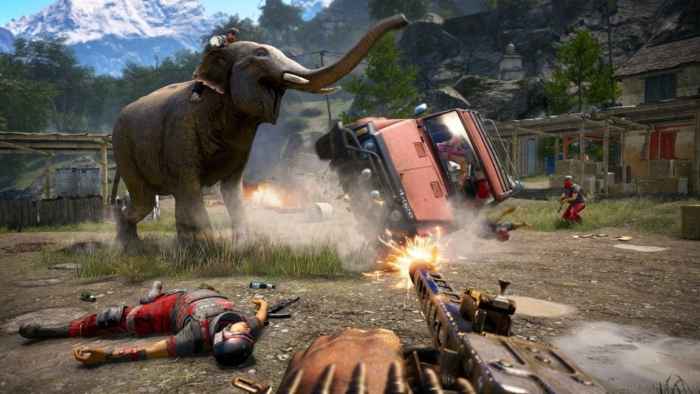
For example, in the recent Far Cry series, it is entirely possible to run upon enemy encampments that are being attacked by wild animals. These are not scripted encounters, hand crafted by the developers. Rather, they are emergent encounters that are the result of the game’s wildlife system interacting with the game’s enemy system. These virtually independent systems have a set of rules that govern how they interact with each other, and that interaction can lead to surprisingly complex behavior. Some other modern games that have a systemic design include MGSV: The Phantom Pain, Watchdogs 2, Dishonored, and the Hitman series. Each one of these games presents an interconnected game world, where one system can affect and react to another system in a realistic and dynamic way. In these games, players are given a goal, then asked to manipulate the games systems in whatever way they want to achieve that goal.
Systemic games are unique because they offer a level of experimentation and player control than that of other more traditional game designs. In more traditional game design, objects and entities in the game world may only really be aware of the player, and not much else. This requires object interaction to be quite direct. In systemic games, on the other hand, objects are aware of and are able to react to a larger amount of things than just the player. This interconnectivity of the game’s different systems gives a large range of options for approaching tasks. How are you going to approach the enemy encampment in Breath of the Wild? Attack head on? Sneak into the camp undetected? Wait for a storm and use the elements to your advantage? Distract the enemies with a bomb, and steal their weapons? Systemic games allow the player to choose their own play style and contribute to the formation of unique events and gameplay experiences. This flexibility truly shines when the player is given a specific goal, then left to their own devices to figure out how to reach that goal.
Potential Drawbacks of Systemic Design
Of course, systemic games are not without weak points, and they are not necessarily superior to games with a less interactive game-world. The Uncharted series is praised for its delivery of tight pacing, great action, memorable characters, and spectacular individual set pieces, all within a relatively linear and constrained game world. One possible weakness of such a flexible and open-ended game design is that it opens up the possibility of game breaking side effects and other bugs. For example, during the development of The Elder Scrolls IV: Oblivion, one developer recalls the headaches of dealing with the new “radiant AI” system, a system designed to govern the behavior of NPCs. The radiant AI system gives each NPC a set of general goals that they each attempt to achieve. The methods they choose are dependent on certain personality values that each NPC is assigned. Sometimes the NPCs would act in unexpected ways to achieve their goals. During one quest line in Oblivion, you are required to meet with a shady skooma dealer. During play testing, developers found that quest line locked, as they would frequently encounter the skooma dealer already dead in his prison cell. It turns out that other NPC skooma addicts would need to get their fix, so they would kill the dealer and take his stash, thus preventing the player from accessing the quest line.
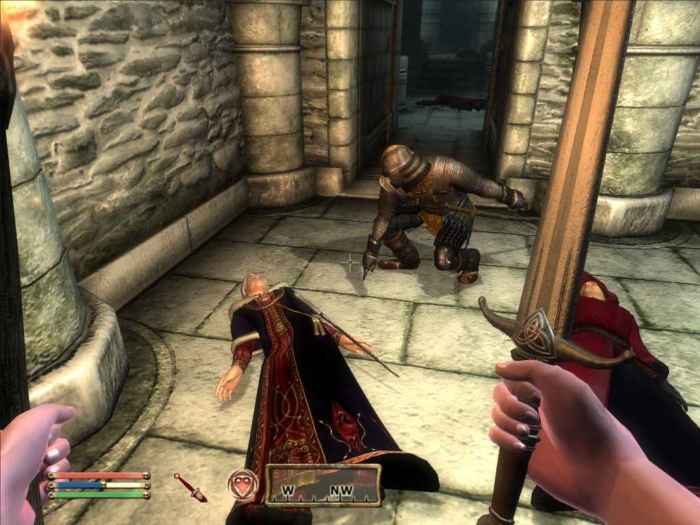
Other developers recall starving guards killing and stealing food from prisoners, NPC villagers robbing stores, and various other unexpected (and sometimes disturbing) behaviors. In the end, Bethesda had to actually scale back the freedom given to NPCs, as they kept engaging in destructive and gamebreaking behavior to achieve their goals. The interaction of many complex game systems can produce behavior that is extremely hard to predict, and these unexpected behaviors can compromise other parts of the game.
Other times, systemic games are so flexible that they allow exploits that make parts of the game trivially easy. Given the flexibility one has to approaching problems, one particular solution may present itself as vastly more efficient than any other solution. Players are then encouraged to not experiment with the different systems, as they have already found the most efficient way to achieve their goals. Part of the difficulty of designing a systemic game is making sure that all the different systems and elements are properly balanced, so as one system does not exert a clearly dominant influence on other systems.
Elements of Successful Systemic Games
So what kinds of features do successful systemic games have? First of all, the rules that govern the interaction of systems must be consistent. A player can only manipulate the game world successfully if the different systems behave in a more or less consistent manner. Guards should react in the same manner to a particular stimulus, NPCs should have a consistent schedule, and objects should behave the same given the same inputs. Without some level of consistency to the behavior of the different systems in the game, it is much harder for the player to make and execute plans.
Second, in the words of Mark Brown on his YouTube series Game Maker’s Toolkit, rules that govern the systems should be “universal” for the class of objects they apply to. For example, in the case of Breath of the Wild, if one wooden object can catch on fire, then all wooden objects should be able to catch on fire. The more exceptions to rules that exist in the game, the less encouragement one has to try different things. The appropriate application of these rules creates a logically consistent game world that encourages and rewards experimentation with unique outcomes and events.
Third, good systemic games have a certain generality to their systems and rules. The more general in character the rules that govern the interaction between systems are, the more potential there is for emergent game play. For example, instead of a programming a guard to react to specific objects in the environment, one can program the guard to react to extremely general types of stimuli, such as noise, light, or motion. In turn, other objects can be defined as having these general set of properties. So instead of the guard looking for specific things, the guard would look for specific types of things. This extra layer of abstraction lets the set of rules that govern interactions between systems be general, yet also allows the player to exploit unseen relationships between systems and objects that the developers did not explicitly intend.
Lastly, good systemic games give the player the means to consciously manipulate the different systems to make plans and solve problems. Breath of the Wild gives the player several runes, among other items, that can be used to manipulate the environment. One rune attracts metallic objects, another creates frozen blocks in water, and another lets you put an object in stasis and build up kinetic energy to send it flying. Each rune give the player a way of directly interact with the environment to create dynamic unique scenarios, and players can make and execute deliberate plans with the tools that they have.
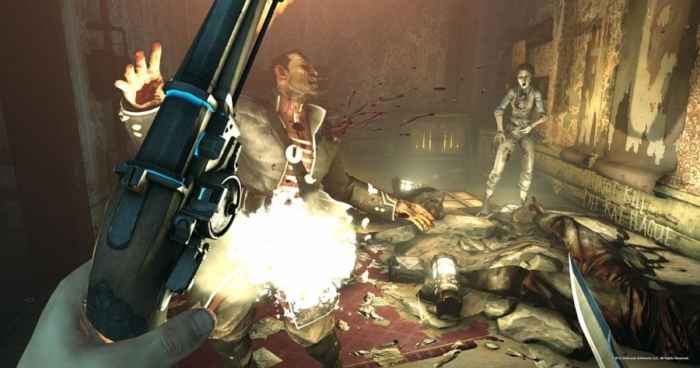
In the same vein, the Bethesda game Dishonored gives the player character an arsenal of tools, weapons, and powers that they can use to reach their objective. Corvo can use his blink power to teleport short distances, use arrows to distract enemies, throw objects to distract guards, summon a swarm of plague rats to attack, and set traps for unaware guards to stumble into. Combining powers and tools to navigate the environment and deal with enemies is an essential part of the game which opens up innumerable avenues for gameplay. Without having some means of consciously manipulating the environment, players would be unable to effectively use a large amount of the functional relationships that exist between different systems. Gameplay would thus be severely limited.
In a certain sense, systemic games have a simple design. Although the individual systems themselves may be complex, the interactions between the systems do not necessarily have to be complex to produce interesting behavior. Systems can have relatively simple rules for interacting with other systems. The complexity sneaks in once these rules and systems start to combine in unexpected ways. Even a simple set of rules can result in complex emergent behavior, as evidenced by John Conway’s famous “Game of Life” cellular automaton program. Conway’s Game of life involves a two-dimensional grid, where each cell is designated as either alive or dead. Each cell interacts with its neighbors, and the state of any particular cell at some particular time is dependent on the state of its neighbors at a previous time. Even with such a simple setup and simple rules that govern the behavior of cells, complex and unpredictable behavior emerges.
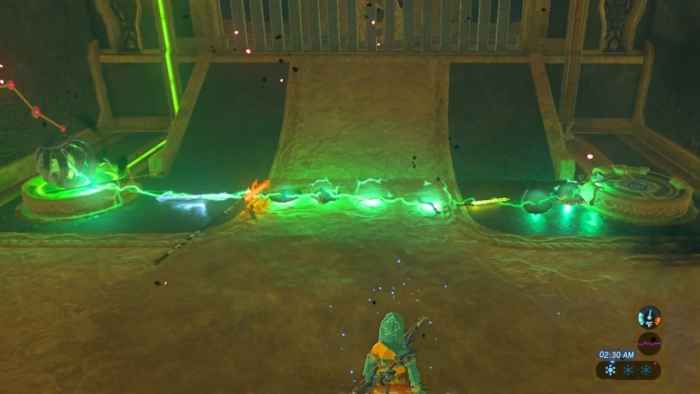
Systemic design is interesting as it allows game designers to create a dynamic and changing world that feels alive and logically consistent. Such a world provides a level of flexibility and open-ended gameplay that rewards experimentation. Breath of the Wild is especially incredible on this front. Never have I played a game that made me say “Wow, that worked!” almost every time I wondered if I could do something. In one particular puzzle, you are required to manipulate electrical currents to open a particular door. The “intended” solution involves finding two electrical orbs and placing them on pedestals next to the door. Instead though, the player can just lay a trail of metal objects, such as swords, shields, and bows from one orb to the other pedestal, thus completing the circuit. I was completely floored when I figured out you could do this. This particular solution to the puzzle makes perfect logical sense, yet most players would not even think to try it as game worlds rarely have such a level of consistency and interconnectedness.
Perhaps the strongest aspect of systemic games is that they provide for a truly unique experience, tailored specifically to each player. No two players will have the exact same play through, and every player will encounter entirely unique moments. This uniqueness also adds to the replay value as the same game can be played multiple different ways. Lastly, spending hours just messing around in these highly interactive worlds is an incredible amount of fun, and after all, isn’t that what games should be going for?
What do you think? Leave a comment.








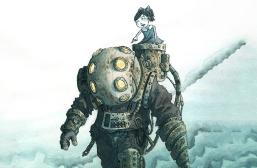


There is a satisfaction in systemic interaction that works so well in games because it is the perfect interactive medium. It’s why I totally forgot the main story of Breath of the Wild but can’t stop coming up with ingenious schemes to mess with Bokoblins!
I think that making a game systematic is one of the best ways to make a game world seem alive/realistic that we have right now. I’m excited to see this concept explored more in the game industry.
In my opinion to design a systemic game is one of the vital parts for designing a realistic/ immersive environment. Because a truly realistic environment does’nt stop as you stop playing it moves forward rather than waiting till you make your move.
Thank you so much, Alex. I hope you will keep on talking about these kinds of subjects in gaming, they’re the sort of stuff that I find most fascinating. Don’t shy away from going as in-depth as you can.
I would love to have a systemic game – immersive sim – based in principle and content of the Olsenbande series of movies, where they used mundane system elements to conduct heists.
Loooovely article. The strongest example I had of systemic gameplay was kingdom come.
Systemic games are amazing. This type of game design I really love! Making plans the developers didn’t even think of thanks to all the interconnected elements, it’s awesome. That’s also why I loved BotW!
borderlands has been doing what farcry 5 does since 2008
Problem with a lot of systemic games: Limiting the choices through narrative. Why kill enemies and go loud in a stealth game like MGS when you could just tranquilise them and ship them to Mother Base? Or Dishonored. Going for the good ending limits you to ghosting, poison arrows and choke holds.
zelda is a pure masterpiece imo
Can systemic game design work well in a platformer? If so, then how?
Breath of the Wild was awesome, but I felt slightly lost because of the lack of big scripted story arcs. I got the memory quest and expected to finish that and get the next quest, only to find that some of the memories were almost impossible to find. I found the celestial dragons and worked hard to find all three, but the Master Sword had nothing to do with them. I feel like BotW skewed just a little too far away from linear scripts, especially since Zelda games have traditionally been completely linear except for the order of dungeons.
The non-linear storyline of the game is actually my favorite aspect because it gives more agency to the player who can tailor the gameplay to their style and in the order they prefer. For example, when I played Breath of the Wild, my interest lay more in world-building and exploration than in the main quest and so I spent the bulk of my time running around and collecting items and solving shrines before tackling the main quest. I can see how many players might be frustrated by the lack of linear direction but it made the systemic game design more immersive and real as a result because it leaves the direction to the player. In a sense, this aspect made the main quest ultimately more compelling, because every supposedly unrelated quest, like the celestial dragons or Satori Mountain for example, made the world more expansive and beautiful and therefore worthy of being saved. Furthermore, the centrality of Hyrule castle and the ugly red smear over it, glimmering constantly in the distance serves as a reminder of the main quest, even while the player is engaged in a less important but no less fun task of say, collecting mushrooms.
Systemic games need to actually trigger their interactions in order to function. A game that failed at this was Shadow of Mordor. During my whole playthrough of that game, I only ever died to non-orc enemies, such as the giant felines called “Caragors”. The exception were two enemies that are guaranteed to die permanently.
As such, its much-heralded “Nemesis” mechanic never came into play and, where other players had epic battles against enemies that they failed to best time and time again and that they developed personal stories with, I only ever saw a bland army of non-descript orcs that died like flies or were far too easy to take control of.
Yes, a systemic game can create interesting encounters, but that is its weakness. It “can” create these encounters. None of them are guaranteed. A game that is controlled by its story, where everyone gets the same content, delivers an experience that is based on its quality, not on sheer luck.
And if a game wants to feature both elements, both need to be of good quality. As such, a systemic game seems like a far riskier purchase for the consumer.
What everyone is really waiting for is for this sort of systemic design to get a foothold in MMORPGs. Everyone is sick to death of these theme-park wow-clones.
Content on The Artifice is always gold.
What I always wish for is a super deep RPG game, but procedurally generated. Sure, you’d want a team of artists to really flesh out all the possible options, but allow things to be mixed up enough gameplay-wise, as far as what the player can do, how player/NPC and NPC/NPC interactions can unfold. How things unlock, etc..
This reminds me a lot of Zoo Tycoon when I put too many animals in the same enclosure
Sometimes you need scripted events to tell a more engaging narrative.
I know skyrim isn’t exactly a role model for this style but it just reminds me of when I had a five way fight with a legendary dragon, a pack of wolves, vampires, and 2 giants
Can’t say how many hours I played Shadow of Modor by experimenting with different combinations I could figure out. The story was god awful, but aggroing a whole camp with a bunch of elites and whittling them away bit by bit was so much fun.
This kind of stuff is why D&D is so fun. The difference is that in D&D (with good DM, at least) anything you do goes and everything else reacts to it in a believable way, meaning you start to approach everything as problems that you can solve as opposed to just tasks you need to do. It’s way more fun to create a solution than it is to just do everything the obvious and boring way, and as a result the campain becomes personalised, shaped by the personalities and actions of the PCs. It takes systematic game design to a whole new level.
Love your two articles! Not only are they interesting and offer well-presented information, they also make me appreciate games on a whole new level. As far as systemic games go, Divinity Original Sin II is a very interesting candidate.
I always knew there was a word for this type of game but I never was able to find it. Now I know the name of my favorite type of games.
BotW’s system is pathetic and I have no idea why everyone is so in love with it. Fire burns wood? No it doesn’t. It burns a very small amount of wooden items that Nintendo absolutely planned to be burned, in a way that is equally as simple as adding an enemy that can be hit with a sword. Why can’t trees and forests be burnt? Why can’t moblin fortresses be burnt? Why can’t ANYTHING in an npc village be burnt? Oh, you can chop things down? No you can’t. You can chop trees. End of story.
How fun would it have been to sneak under a tree fortress and chop down one of the supports (or set fire to it) and watch the whole thing collapse with enemies sliding and falling off. Every single video demonstrating all the ‘amazing’ ‘unplanned’ ’emergent’ gameplay in BotW shows the exact same set of things, to the point where it becomes identical to people showing off a heavily scripted set piece from CoD or Uncharted.
The most impressive thing Nintendo did in BotW was to convince players that yet another video of somebody flinging themselves around on a boulder is worthy of anyone’s time.
The BotW physics engine is bullshit.
THE game that entices me most with what we call “emergent gameplay” is clash royale. Like, the competition is fun; the spells are cool. But the simple distinction between dealing with hog frost at release and the difference between that and how now you can just tornado the hog back to your big tower and get all 3 crown towers to target it and increase your homeland firepower from the start of the game is like… The epitome of fun in that game.
Systemic game desing have a lot in commun with pen and paper game design.
Duck game is my favorite example of this. It doesn’t necessarily have ai but the systems and physics in that game are so deep especially for a good joke game.
it is intense for me to see that everything i thought of like 15 years ago is not only possible but at our fingertips with a few clicks…the games, the tech behind them, everything…i love it
I think it’d be cool to have lots of systems like this and then add a magic system that lets you alter it, say: Create a fire that doesn’t get extinguished, prevent wood from burning or make metal and stone burn, create rain or snow or summoning monsters to attack dudes etc
Are there systemic games (probably single player) where we can change the input/rule/output through addons or directly in game ? Then share your crazy world with others ?
Space station 13 is worth looking into if you want to experience this sort of thing. It’s free and there is an excellent video by mandalore gaming to give you a run down of what to expect.
Just read this article => intant sub to newsletter. Such an interesting subject and website, keep it up!
In FarCry I had just fought tooth and nail to save some dude from a bunch of idiots. After it was over I was walking up to him to get my reward and he was all like “you saved my life man” when right out of nowhere my vision is filled with rhino ass as it steamrolled into him, killing him instantly. I had no clue that thing was even in the area, and it scared the absolute shit out of me. All I could do was yell “oh fuck!” and hightail it out of there. Damn horror games, nothing has brought me closer to a real life heart attack than FarCry’s unexpected animal encounters.
I would say that Prison Architect is the best example of systems in any game. ever
The elephant in the room is that Bethesda Game Studios have not made their games more systemic. In fact, that’s a large reason why they feel so paper-thin.
very informative
Now I know what kind of game I love playing.
I think some games have a systemic core, but only think about advantages – not sure if these would count a s systemic.
I really enjoyed this article. I just finished BOTW again for the 3rd time and I saw it with some new appreciation after reading this article. Great job!
My first Legend of Zelda game I ever played was Ocarina of Time, and it is still probably my favourite game of the series. I am yet to play Breath of the Wild (Late to the band-wagon for this too) but if its gameplay is anything like Ocarina of time, Twilight Princess, or Skyward sword, I will inevitably love it. I know that the gameplay is quite different from the past games, and that there is a wider game scale, but to hear that the game has even included side quests along with the main quests, makes me very keen to play 🙂
I always love when something happens as a result of the game world itself rather than a direct interaction. It’s always a nice touch.
I do enjoy gameworlds that operate through systemic game mechanics, but I am also of the opinion that there are instances where these mechanics are either artificially padding the game’s length or trying to make up for shallow narrative immersion. The best example I can think of would be that of Red Dead Redemption 2 own systemic game design. While it did add a layer of depth into the gameworld, the systemic game elements deliberately paused or simply offered unnecessary roadblocks to the gameplay experience (sometimes it felt like you were fighting against the game). From the constant frustration of having to chase down and figure out where NPCs were at any given moment, to the sluggish moments that bogged down gameplay and added little to no substance (and the obviously troubling game development practices by Rockstar) the mechanics only served either as eye candy or time padding. On the other hand, some games try to sell upfront their systemic game mechanics, but upon playing them, they have an extremely shallow narrative and often feel like technical or mechanical demos/prototypes. As much as I loved playing Breath of the Wild, there is no mistake that it is the most narratively weak Legend of Zelda game (and yes, I am including the Philips CDI ones as well). While the game actively encourages the player to experiment through gameplay and explore Hyrule, it does very little to motivate the player into fighting Ganon. I know that many people draw comparisons to the first Legend of Zelda game, but what many seem to overlook is that the game manual actually gives the player the lore and purpose as to why Link is in his adventure whereas BoTW does little outside of nudging the player into the tutorial area (which they may choose to skip entirely). It’s weird to say that the systemic game mechanics are working as a narrative crutch in BotW, but it often times feels like that’s the case. I am by no means advocating for strictly linear and scripted games but instead would rather have the use of systemic game mechanics used purposefully rather than as a crutch or for padding out gameplay.
But what about the narratives the player gets to tell? I think this is the signature promise of systems-driven gameplay, and of gaming in general, that players end up telling their own narrative through their unique experiences in that game world. Breath of the Wild is teeming with dramatic elements, told primarily through environmental storytelling, that engages the player’s imagination. I think calling systemic game mechanics a narrative crutch can only be valid if viewing narrative through the lens of traditional non-interactive media. Lost in that discussion are the ways in which gameplay systems themselves can tell a story and engage players emotionally.
In my personal experience, Breath of the Wild excited me far more when it came to storytelling than quite a few other Zelda games I’ve played because it allowed me to be a participant in the narrative. It gave me the building blocks of a narrative and the gameplay structure of a heroic dramatic arc while letting me attach my own meaning, which felt more personal, the type of narrative experience only a video game can tell. Done well and with intention, I frankly find this a lot more powerful than what non-interactive media is capable of.
Un-interactable objects that follow the appearance of another element in games really discourages the player from experimenting anymore since it is a “waste of time”, so this article hits many of the highlights behind the consistency of a game’s laws
Wind Waker is another example of a Zelda game with a certain degree of systematicness; however, admittedly, to a far less degree than Breath of the Wild. This is found in the combat system which equips the player with a plethora of items utilities to slay enemies. I found that floor masters were a source of stress for me in the wind temple since there was a limited amount of time to deal damage before being swept away. Not until I glossed over one of Chuggaaconroy’s playthrough of Wind Waker did I realize that using an ice arrow in conjunction with the skull hammer would garner an instant kill. The enemy’s ice. Ice can be shattered. Obviously, Wind Waker lacks in the element of a consistent system since methods have their limits as to where they can be used, unlike Breath of the Wild where the system, from gameplay I’ve seen (haven’t got to play it yet ughhhh), is so consistent that it works in scenarios that the player would rule out considering how much sense they make for a video game.
A great explanation and exploration of systemic games. I loved Breath of the Wild for this reason (among others) and its exciting to see the curve of complexity as you play develop. Learn more about the world, uncover more combinations and create more emergent gameplay. It feels as though you’re unlocking content in a way but just actual experience not quantifiable points as is typical.
A good explanation of concepts. I think design and colours plays important role in Human Psychology and impact on Human directly. Same goes with gaming, a good colour scheme gave good vibe in game.
Yes!! this is something I never knew the name for but which made playing zelda such a joy. My girlfriend played BOW through before we met, and then once we were dating introduced me to the game and watched me play. She was consistently shocked by choices I would make and found that we had played the game in drastically different ways. I thought it was so neat to get to explore how differently we approach problems (and life) through playing this game together!